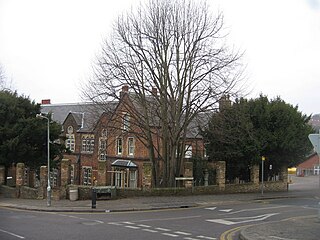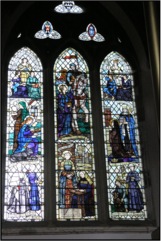Frances Dove
 | |
| Data urodzenia | |
|---|---|
| Data śmierci | |
| Zawód, zajęcie | |
| Miejsce zamieszkania | 26 Priory Avenue, High Wycombe |
| Narodowość | |
| Alma Mater | Girton College, Cambridge, |
| Pracodawca | Cheltenham Ladies College, |
| Odznaczenia | |

Dame Jane Frances Dove (ur. 27 czerwca 1847, zm. 21 czerwca 1942) – angielska nauczycielka i działaczka oświatowa, feministka, założycielka Wycombe Abbey i innych szkół dla dziewcząt, sędzia pokoju, odznaczona Orderem Imperium Brytyjskiego.
Życiorys
Dzieciństwo i studia
Była córką duchownego z Lincolnshire. Studiowała nauki przyrodnicze w Girton College, Cambridge – pierwszej brytyjskiej szkole wyższej dla kobiet, utworzonej w roku 1869, gdy Frances Dove miała 22 lata. Kolegium ukończyła, jako jedna z pierwszych absolwentek, w roku 1874[1]. Girton – obecnie pełnoprawne kolegium University of Cambridge – nie miało uprawnień do przyznawania dyplomów ukończenia studiów. W tej sytuacji kobiety starające się o potwierdzenie swoich kwalifikacji były zmuszone ubiegać się o dyplomy poza Anglią (Uniwersytet Oksfordzki i University of Cambridge były dla nich zamknięte). Frances Dove należała do kobiet podróżujących w tym celu do Irlandii, gdzie miały możliwość otrzymania dyplomów w Trinity College w Dublinie[2][3]. Ze względu na środek lokomocji, z którego najczęściej korzystały, były nazywane „steamboat ladies”. Miss Dove otrzymała stopień M.A. w roku 1905[4].
Działalność na rzecz edukacji kobiet

W pierwszych latach pracy w dziedzinie organizacji instytucji edukacyjnych dla dziewcząt i kobiet Frances Dove współpracowała z Dorotheą Beale (1831–1906), kierującą od roku 1858 do śmierci Cheltenham Ladies' College (założonym w roku 1854)[5], zapamiętaną również jako założycielka Oxford hall for women w Uniwersytecie Oksfordzkim (1893) i St Hilda's College w Oksfordzie (działające od roku 1893 kolegium żeńskie)[6][7].
Frances Dove została w roku 1877 zastępczynią Mistress[a] Cheltenham Ladies' College[1]. W następnych latach włączyła się do organizacji St Andrews School for Girls w Fife (St Andrews, Szkocja), założonej w roku 1877 (później nazwanej St Leonard’s School. W latach 1882–1895 pełniła funkcję drugiej z kolei Headmistress[8].
W roku 1895 odeszła z St Leonard’s School, aby podjąć najbardziej doniosłe dzieło swojego życia – organizację podobnej szkoły dla dziewcząt w Anglii południowej, w High Wycombe (Buckinghamshire). W Wycombe Abbey School uczyło się początkowo 40 dziewcząt. Szkoła zajmowała posiadłość Abbey (z 30 akrami ziemi) zakupioną w roku 1896 od trzeciego barona Carringtona (zob. baronowie Carrington). Frances Dove została pierwszą headmistress; pełniła tę funkcję przez czternaście lat. Pracowała w Wycombe Abbey do emerytury w roku 1910, a również po jej uzyskaniu[8][1].
Była aktywna również poza Abbey. Zaangażowała się w tworzenie Godstowe School (1900) pierwszej w Anglii powszechnej szkoły podstawowej dla dziewcząt, którą założyła i kierowała Mrs Scott, zachęcana i wspierana przez Frances Dove. Godstowe od początku istnienia ściśle współpracowała z Wycombe Abbey (kontakty zostały zachowane do XXI w.)[9].
Frances Dove założyła w High Wycombe Central Aid Society (1906), które do czasów współczesnych pomaga potrzebującym. Przyczyniła się do założenia St John’s Church oraz Loakes Park School, założyła miejską bibliotekę i Children's Health Centre[10]. W roku 1907 została wybrana do High Wycombe Borough Council; w następnym roku kandydowała na burmistrza High Wycombe (co było ewenementem), jednak radni-mężczyźni nie wyrazili zgody na zwierzchnictwo kobiety. Ograniczono się do przyznania jej dwóch głosów w czasie Special General Meeting's[10].
Kolejną szkołę, wzorowaną na Wycombe Abbey i Benenden School, założono w roku 1923 w Kent, pod nazwą Benenden School. Jej założycielkami i początkowymi kierowniczkami były trzy wcześniejsze członkinie zespołu pedagogicznego z Wycombe[11].
Publikacje
Książki w books.google.pl[12]:
- Madeline Agar, Jane Frances Dove: A Primer of School Gardening… (wprowadzenie: J.F. Dove), Wydawca London, 1909,
- Dorothea Beale, Lucy Helen Muriel Soulsby, Jane Frances Dove, Work and Play in Girls' Schools (Longmans, Green, 1898, 1901).
Uhonorowanie i upamiętnienie
Frances Dove została odznaczona Orderem Imperium Brytyjskiego z tytułem dame (1928). Otrzymała też tytuł sędziego pokoju (Justice of the Peace, 1921).
W tzw. „Dove Window” – jednym z witraży Kościoła pw. Wszystkich Świętych w High Wycombe[13], upamiętniono nie tylko Frances Dove; w witrażu znajdują się wizerunki i nazwiska wielu innych kobiet, które wytrwale przeciwdziałały męskiej dominacji. Obok wizerunków Świętej Małgorzaty Szkockiej, Małgorzaty Beaufort i innych historycznych postaci, zamieszczono m.in. nazwiska: Emily Davies, Elizabeth Garrett Anderson, Octavia Hill, Sophia Jex-Blake[14].
Portrety Dame (Jane) Frances Dove (1847–1942) – Founder of Wycombe Abbey School and Governor of Girton College – znajdują się w kolekcji National Portrait Gallery w Londynie[15]. Na ścianie budynku przy 26 Priory Avenue, w którym mieszkała, ulokowano pamiątkową Blue plaque z napisem Dame Frances Dove (1847–1942), Dame and educator[16]. Elsie Edith Bowerman opisała jej życie w biograficznej książce pt. Stands There a School: Memories of Dame Frances Dove, D.B.E., Founder of Wycombe Abbey School[17].
– okolice miejsca zamieszkania Frances Dove
w High Wycombe
w All Saints Church
Uwagi
Przypisy
- ↑ a b c History of the School (ang.). W: Wycombe Abbey School, High Wycombe, Buckinghamshire [on-line]. www.wycombeabbey.com. [dostęp 2013-12-30].
- ↑ A Short History (ang.). W: Strona internetowa Trinity College Dublin [on-line]. www.tcd.ie. [dostęp 2013-12-30].
- ↑ Susan M. Parkes: A danger to the men?: a history of women in Trinity College Dublin 1904-2004 (ISBN 1843510405 (ang.). W: Inff. bibl. w books.google.ie [on-line]. Lilliput Press, Uniwersytet Michigan, 2004. [dostęp 2013-12-30].
- ↑ Trinity Hall’s Steamboat Ladies (ang.). trinitynews.ie, March 14, 2012. [dostęp 2013-12-30].
- ↑ Dorothea Beale. W: Spartacus Educational > British History > British Education [on-line]. www.spartacus-educational.com. [dostęp 2015-12-11]. [zarchiwizowane z tego adresu (2014-04-19)].
- ↑ College History - Constitutional History (ang.). W: Strona internetowa St Hilda's College (Uniwersytet Oksfordzki [on-line]. www.sthildas.ox.ac.uk. [dostęp 2016-11-03].
- ↑ Women and Schooling. W: Spartacus Educational > British History > Women's Suffrage > Schooling [on-line]. www.spartacus-educational.com. [dostęp 2015-12-17].
- ↑ a b Our School > History (ang.). W: Strona internetowa St Leonards School, St Andrews, Fife, Scotland [on-line]. [dostęp 2013-12-31].
- ↑ History of Godstowe (ang.). W: Strona internetowa Godstowe Preparatory School [on-line]. www.godstowe.org. [dostęp 2016-03-17].
- ↑ a b Jane Frances Dove (ang.). W: Biography [on-line]. Chilterns Conservation Board. [dostęp 2013-12-31].
- ↑ History of Benenden (ang.). W: www Benenden School, Cranbrook, Kent [on-line]. www.benenden.kent.sch.uk. [dostęp 2013-12-31].
- ↑ inauthor:"Jane Frances Dove". W: books.google.pl [on-line]. [dostęp 2013-12-31].
- ↑ 'All Saints Church' w High Wycombe (ang.). W: Strona intrnetowa kościoła [on-line]. [dostęp 2013-12-30].
- ↑ Edited by Peter Cormack: Women Stained Glass Artists of the Arts and Crafts Movement: Exhibition Catalogue (Paperback). 7 grudnia 1985. ISBN 978-0-901974-22-8. (cyt. według en:wiki, zob. 'All Saints')
- ↑ Portrety Dame (Jane) Frances Dove (1847–1942), Founder of Wycombe Abbey School and Governor of Girton College (ang.). W: Kolekcja National Portrait Gallery w Londynie [on-line]. [dostęp 2013-12-30].
- ↑ Dame Frances Dove (1847 – 1942), Dame and educator (ang.). W: Documenting the historical links between people and places, as recorded by commemorative plaques [on-line]. openplaques.org. [dostęp 2013-12-30].
- ↑ Elsie Edith Bowerman: Stands There a School: Memories of Dame Frances Dove, D.B.E., Founder of Wycombe Abbey School (ang.). W: Informacja bibliograficzna [on-line]. Wycombe Abbey School, 1966. [dostęp 2013-12-30].
Media użyte na tej stronie
(c) Sebastian Ballard, CC BY-SA 2.0
Priory Avenue / Priory Road Hamilton Primary School, with classic Victorian buildings marks the corner.
Frances Dove, from a 1909 publication.
(c) Peter Jemmett, CC BY-SA 2.0
All Saints Parish Church
Lady of the Lake, Lake Washington steamboat, built 1897, later worked on Puget Sound as a tug under name of Ruth.
Baretka Orderu Imperium Brytyjskiego (cywilnego; 1917-1935).
Autor: Weglinde, Licencja: CC0
The three-light window in All Saints' High Wycombe is known as the “Dove Window” and remembers Frances Dove (1847-1942). It was designed by Caroline Townshend and Joan Howson. Frances Dove was one of the first students to enrol at Girton College and became founder and first headmistress of Wycombe Abbey School for girls in 1896. She was an active advocate of “women’s rights” and when the 1907 Qualification of Women (County and Borough Councils) Act was passed, which gave women the right to sit on local councils even though they could not vote, she was one of the first women in the country to be elected. In 1908 she was invited by the Council to become the Mayor and although Miss Dove had been elected by the Council this was overturned at the public “mayor making” ceremony when a male candidate stepped forward. This “mayor making” ceremony would take place in the market square ( an ancient weighing-in ceremony) at which the “mayor elect” is acclaimed by the people. Never before or since was another candidate brought in at that ceremony and “elected” by acclamation of the crowd, a crowd on that occasion no doubt packed with anti-feminists. Although Dove was not elected the Bucks Free Press noted that she was the only person to come out of the meeting with dignity. It seems she chose to wear a scholar’s cap with her councillor’s robes and High Wycombe women councillors still wear scholar’s caps with their robes to this day. She retired as headmistress in 1910, was appointed a JP, supported the Suffragettes and in 1928 was made a dame. She presented the window to the parish church to pay tribute to the achievement of women through the ages, in the face of male domination. The window was dedicated on Ascension Day in 1933. In the left panel, Townshend and Howson depicted Charlotte Brontë, Emily Davies, the first principal of Girton, St Bridget, St Winifred, Elizabeth Fry, the prison reformer and Florence Nightingale. They also listed the names of Maud Royden and Dame Millicent Fawcett, both suffragettes, Agnata Ramsay, the first woman to achieve a classics tripos at Cambridge, Mary Kingsley, Hannah More, anti-slavery writer and friend of Wilberforce and Edith Cavell. In the centre panels are depictions of St Margaret the Scottish Queen, Margaret Roper, daughter to Sir Thomas More, Margaret Beaufort, mother of Henry VII and benefactress of Oxford and Cambridge universities and Ann Clough, the first principal of Newnham College and the names Josephine Butler the social reformer, Octavia Hill, co-founder of the National Trust, Jenny Lind, opera singer, Sophia Jex-Blake, a pioneer of medical education for women, Elizabeth Garret-Anderson, first woman member of the British Medical Association and Agnes Jones the nurse praised by Florence Nightingale. In the right hand panel were depicted Grace Darling, Queen Victoria, Christina Rosetti and St Hilda together with the names St Frideswide, Mary Slessor the Scottish missionary, Alice Marval who died caring for plague victims in India, Amy Johnson, and Elsie Inglis a suffragette who took women’s medical units to serve on the Western Front in the Great War.









